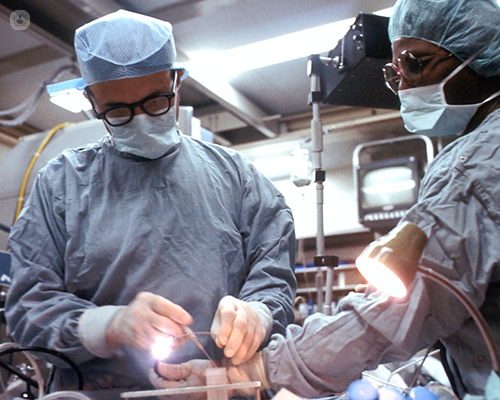TAVI for aortic stenosis (Part 2): Preparation, the procedure and recovery
Escrito por:TAVI stands for 'transcatheter aortic valve implantation' and is sometimes also called TAVR (transcatheter aortic valve replacement). It is a keyhole, X-ray-guided method of delivering a new heart valve to patients who have aortic valve disease.
Leading consultant interventional cardiologist Dr Christopher Malkin considers preparing for the procedure, what happens in the operation and recovery in Part 2 of his guide to TAVI for aortic stenosis.

Preparing for the TAVI procedure
Once the decision has been made that you need a TAVI procedure, there is a lot to plan for in a short time.
- Although TAVI is nearly always performed without the need for a general anaesthetic, it is still a big procedure and you should plan for 2 - 3 days in the hospital.
- The pre-admission procedures are done with a planning phone call and a short visit to perform blood tests and paperwork.
- If you are taking anticoagulants (such as warfarin) you may be asked to stop these before hospital admission, but it is essential that you check with the admitting team before changing medication.
- You will be asked to read and sign a consent form. As with any major procedure, TAVI is associated with some risks, but your doctor will talk you through any concerns. It is important that you understand what the treatment is for, and that the balance of risk and benefit is correct.
- We will also talk to you about recovery. Before the procedure, you should remain modestly active and mobile, but you should not exercise because this can put extra strain on the heart.
COVID-19
You may need to be tested for COVID-19 and asked to pre-isolate and use a specific anti-bacterial cleaning agent to the skin.
Anaesthetic and drips
Most TAVI procedures are performed by delivering a specially-designed heart valve from the large artery in the groin to the correct position at the top of the heart. Usually, the procedure is performed while the patient is awake. Local anaesthetic is used to insert any lines and drips. Painkillers and sedatives are used only if needed.
Usually, three drips are inserted:
- A small one in a vein in the arm to give medications and fluids.
- A small one in the wrist to measure blood pressure and give X-ray dye.
- A large tube in the femoral artery (via the groin) to deliver the heart valve.
How many specialists help perform TAVI
There are lots of people in the operating and X-ray room during the TAVI procedure. The first few minutes can seem quite overwhelming as you meet the team.
In addition to the two consultants performing the procedure, there is:
- A senior experienced nurse or anaesthetist to make sure you are comfortable and relaxed. In the middle of the procedure, they will even scratch your nose for you.
- A radiographer who is in control of the X-ray camera. They deliver the X-ray contrast.
- An ECG (electrocardiogram) technician. They are responsible for monitoring the ECG, documenting the procedure, and operating the temporary pacemaker.
- An echocardiographer. They are responsible for checking the valve and heart function before and after the procedure.
- Two additional nurses to assist the doctors and help prepare the equipment.
The length of the TAVI procedure
The whole procedure takes around 90 minutes. Most patients just want to drift off to sleep and want to be told when it is all done. Talk to your team about what you prefer.
How patients feel during the procedure
There are usually three keys stages of the procedure that you may notice and perhaps feel.
- The first is when the large delivery sheath is inserted in the groin. This is associated with a stretching feeling that is uncomfortable for a few seconds.
- The second is when the heart valve is delivered to the heart. At this point, the doctors deliberately lowers the blood pressure by pacing the heart quickly; you will feel your heart racing and perhaps feel lightheaded.
- The third is when the equipment is removed from the groin. Sutures (stiches) are used to close the hole and usually, five minutes of heavy pressure is required to completely stop residual bleeding.
The hospital stay after TAVI
The big advantage of TAVI is that patients get better and return home quickly. After your TAVI procedure, you will be returned to a regular ward. If the procedure has gone perfectly well with no problems (this occurs in 95 per cent of cases), you will have to remain in bed for four hours before we start to gently mobilise you. Most patients can return home the following day.
In some patients, more time is required in the hospital to observe and potentially treat other issues.
Pacemakers after TAVI
Sometimes, a permanent pacemaker is needed after TAVI, and this is required in roughly 10 per cent of cases. If the doctors think that a pacemaker might be needed, you may need to stay in the hospital for two full days to monitor the ECG or to have a permanent pacemaker implanted. A pacemaker is another separate procedure, but it is much more straightforward than a TAVI operation, and often you can go home the same day.
Possible complications
Occasionally, there are other concerns such as bleeding (usually from the groin artery) or cardiac and kidney function disruption after TAVI. These issues settle down quickly, but they may require a longer stay in hospital to be monitored.
Moving after surgery
You should not drive within 28 days of having the TAVI procedure.
After TAVI is performed, you should find that your function and ability to walk improve rapidly. Modest exercise can be resumed gradually over a few weeks. You can gradually progress the intensity of movement as soon as you go home, and gradually build up your exercise. You should not exercise vigorously or lift anything heavy until you have had an echo check and a consultation six to eight weeks after surgery.
Medication after TAVI
We usually advise patients to take aspirin long term. Anticoagulation (blood thinning) is not required unless there is another specific reason, such as previous blood clots or an irregular pulse (atrial fibrillation).
Other medications that you have been on long-term will usually continue. Some drugs may be reduced, such as diuretics (water pills), and if so, we usually do this when you’re discharged from the clinic.
Don’t forget to read Part 1 for a detailed explanation of the benefits and risks of TAVI, and how to know if TAVI or open surgery is the right procedure for your aortic stenosis treatment.
Dr Christopher Malkin is a specialist in the TAVI procedure. Visit Dr Malkin's Top Doctors profile to discover how he can help you take care of your heart.


